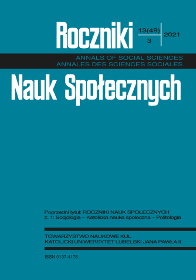American Commonalities and Roots of European Integration
Abstract
This article looks deeply into the historical parallels between the American and European experiences of state integration, which have resulted in the United States of America and the European Union, respectively. It first defines the key international relations concept of state integration and compares American and European thought on the idea. It then turns to examine some of the highpoints in the history of integration in the American and European cases. Given the remarkable historical commonalties between the two processes, the article puts forward the idea of the American experience as a chief inspiration and source for European integration. It concludes by suggesting that without the historical example of the United States, as well as massive American post-war assistance to Europe, it is highly doubtful that European integration would have commenced when and as it did.
References
Alter K., Steinberg D. (2007), The Theory and Reality of the European Coal and Steel Community, [in:] S. Meunier, K. McNamara (Eds.), Making History: European Integration and Institutional Change at Fifty, Oxford: Oxford University Press, pp. 89–104.
BBC (2013), Thatcher and Her Tussles with Europe, 8 April 2013, https://www.bbc.com/news/uk-politics-11598879 [Accessed: 30.06.2021].
Beer S. H. (1978), Federalism, Nationalism, and Democracy in America, American Political Science Review, 72 (1), pp. 9–21.
Bowen K. D. (1986), Miracle at Philadelphia, New York: Bay Back Books/Little, Brown & Company.
Carey G. W. (1997), In Defense of the Constitution, Carmel: Liberty Fund.
Davidson E. (1999), The Death and Life of Germany, Columbia: University of Missouri Press.
De La Serre E. B. (1989), Foreign Policy of the European Community, [in:] R. Macridis (Ed.), Foreign Policy in World Politics, States and Regions, Englewood Cliffs: Prentice Hall, pp. 345–373.
Deutsch K., et al. (1957), Political Community and the North Atlantic Area: International Organization in Light of Historical Experience, Princeton: Princeton University Press.
Eur-Lex (2017), Treaty Establishing the European Coal and Steel Community, ECSC Treaty, https://eur-lex.europa.eu/legal-content/EN/TXT/?uri=LEGISSUM%3Axy0022 [Accessed 30.06.2021].
Evans-Pritchard A. (2000), Euro-Federalists Financed by US Spy Chiefs, The Telegraph, 19.09.2020, https://www.telegraph.co.uk/news/worldnews/europe/1356047/Euro-federalists-financed-by-US-spy-chiefs.html [Accessed: 30.06.2021].
Freiberger T. (2010), Der friedliche Revolutionär: Walter Hallsteins Epochenbewusstsein, [in:] V. Depkat, P. Graglia (Eds.), Entscheidung fuer Europa – Decidere l’Europa: Erfahrung, Zeitgeist und politische Herausforderungen am Beginn der europäischen Integration, Berlin, New York: De Gruyter, pp. 205–242.
Fulbright W. J. (1948), A United States of Europe?, The Annals of the American Academy of Political and Social Science, 257(1), pp. 151-156, https://doi.org/10.1177/000271624825700116 [Accessed: 30.06.2021].
George A. (2018), The American Revolution was Just One Battlefront in a Huge World War, Smithsonian Magazine, https://www.smithsonianmag.com/smithsonian-institution/american-revolution-was-just-one-battlefront-huge-world-war-180969444/ [Accessed: 30.06.2021].
Gizicki W. (2009), Development Issues of the European Union, [in:] W. Gizicki (Ed.), European Union Present and Future, Lublin: Catholic University of Lublin, pp. 197–194.
Haas E. (1968), The Uniting of Europe, Stanford: Stanford University Press.
Hugo V. (1849), Speech to the Peace Conference at Paris, https://trove.nla.gov.au/newspaper/article/12914658 [Accessed: 30.06.2021].
International Churchill Society (2021), United States of Europe Speech, 19 September, 1946, University of Zurich, https://winstonchurchill.org/resources/speeches/1946-1963-elder-statesman/ united-states-of-europe/ [Accessed: 30.06.2021].
Leuchtenburg W. (2011), In the Shadow of FDR: From Harry Truman to Barack Obama, Ithaca: Cornell University Press.
Lovett A. W. (1996), The United States and the Schuman Plan. A Study in French Diplomacy 1950-1952, The Historical Journal, 39 (2), pp. 425–455.
Lowi T. J. (2006), The End of the Republican Era, Norman: University of Oklahoma Press.
Madison J. (1787a), The Federalist 10, [in:] J. M. Shafriz, L. S. Weinberg (Eds.) (1994), Classics in American Government, Belmont: Wadsworth Publishing, pp. 210–215.
Madison J. (1787b), Vices of the Political System of the United States, National Archives, https://founders.archives.gov/documents/Madison/01-09-02-0187 [Accessed: 30.06.2021].
Madison J. (1788), The Federalist 39, [in:] J. M. Shafriz, L. S. Weinberg (Eds.) (1994), Classics in American Government, Belmont: Wadsworth Publishing, pp. 52–55.
Martin J. K., et al. (1989), America and its People, Volume One, to 1877, Glenview: Scott, Foresman & Company.
Mitrany D. (1966), A Working Peace System, [in:] B. F. Nelsen, A. Stubb (Eds.), The European Union: Readings on the Theory and Practice of European Integration, Boulder: Lynne Rienner Publishers, pp. 93–113.
Monnet J. (1978), Memoirs, Garden City: Doubleday & Company.
Nelsen B. F., Stubb A. (2003), The European Union: Readings on the Theory and Practice of European Integration, Boulder: Lynne Rienner Publishers.
Rappaport A. (1981), The United States and European Integration: The First Phase, Diplomatic History, 5(2), pp. 121–149.
Riemer N. (1967), The Democratic Experiment: American Political Theory—Volume I, Princeton: Van Nostrand Company.
Rose R. (1991), What is Lesson-Drawing, Journal of Public Policy, 11(1), pp. 3–30.
Sbragia A. M. (1992), Thinking About the European Future: The Uses of Comparison, [in:] A. M. Sbragia (Ed.), Euro-Politics, Washington D.C.: The Brookings Institution, pp. 257–291.
Shafriz J. M., Weinberg L. S. (Eds.) (1994), Classics in American Government, Belmont: Wadsworth Publishing.
Vatican News (2021), Robert Schuman, Father of European Unity, on Path to Sainthood, 19 June 2021, https://www.vaticannews.va/en/pope/news/2021-06/robert-schuman-father-of-european-unity-on-path-to-sainthood.html [Accessed: 30.06.2021].
Wilford H. (2003), Calling the Tune? The CIA, the British Left, and the Cold War, 1945–1960, Intelligence and National Security, 18(2), pp. 41–50.
Copyright (c) 2021 Roczniki Nauk Społecznych

This work is licensed under a Creative Commons Attribution-NonCommercial-NoDerivatives 4.0 International License.


